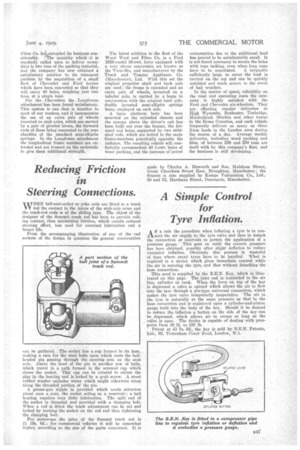SIX-WHEELER CONVERSIONS for Carrying Bulky Loads
Page 72

Page 73

If you've noticed an error in this article please click here to report it so we can fix it.
The Experience of Many Years Causes an Industrial User to Standardize on Sixwheelers for Carrying Fibrous Material.
IN the matter of selecting a type of vehicle for a certain class of work one is always glad to hear the opinions of a company which has had a really long experience and which has based its conclusions upon the results of extended trials. For this reason the choice which the Wood Wool and Fibre Co., of flackney Wick, London, E.9, has made, in the problem of conveying its large output of fibre and wood-packing material, is of interest to all who have to undertake the carrying of light and cumbersome loads of this nature.
The Wood Wool and Fibre Co. has been a regular user of commercial motors for its transportation since some little time before the war, and it has, in its 15 or more years of operating experience, made use of many types of vehicle.
A bale of wood packing, tightly compressed, weighs about 1 cwt., but the difficulty is that, due to the nature of the material, the length of such a bale is over 4 ft., the width and height each being as much as 2 ft. 6 ins. In the early days of conveyance by motor, orders for about one ton of this packing were the regular experience, and the company employed 1-ton chassis for its delivery work. Flat-platform bodies of the largest possible dimensions were fitted, but it was found that 13 or 15 bales constituted the limit of load that could be accommodated on these lorries, and delivery costs were heavy because the chassis never carried the payload for which they were intended.
B46 Some attempts to enlarge the carrying capacity of the vehicles were made, but it was not until after the conclusion of the war that the company was able completely to remedy matters. One of the early efforts in this direction comprised the employment of a plain frame extension combined with the use of an extended propeller shaft and strong semielliptic rear springs. The adoption of this equipment enabled 30 bales to be loaded upon a 1-ton Ford chassis and resulted immediately in a reduction in transport costs. One, vehicle couverte0 in this manner by means of the Olson extension unit and having three years' service to its credit is still performing regular daily work for the company.
Of recent years the Wood Wool and
Fibre Co. haftvextended its business con
siderably. The quantity which it is regularly called upon to deliver nowadays is two tons of the packing material, and the company has now obtained a satisfactory solution to its transport problem by the acquisition of a small fleet of Chevrolet and Ford lorries which have been converted so that they will carry 40 bales, weighing just two tons, at a single load.
For the Chevrolets the Longframo attachment has been found satisfactory. This system is ione that is familiar to most of our readers, and it incorporates the use of an extra pair of wheels mounted on stub axles, which are carried
a pair of pivoted levers, the forward ends of these being connected to the rear shackles of the standard semi-elliptic, springs. In the Longframe attachment the longitudinal frame members are extruded and are trussed on the underside to give them additional strength.
The latest addition to the fleet of the Wood Wool and Fibre Co. is a Ford 1929-model 30-cwt, lorry equipped with a very clever conversion set known as the Twin-Six, and manufactured by the Truck and Tractor Appliance Co. (Manchester), Ltd. •With • this set the original propeller shaft and back axle are used ; the frame is extended and an extra pair of wheels mounted. on a tubular axle, is carried by a bogie in conjunction with the original back axle, double inverted semi-elliptic springs being employed on each side.
• A large platform body has been mounted on the extended chassis and the canopy above the driver's cab has been built out over the bonnet, the forward end being supported by two mildsteel rods, which are bolted to the main frame-members practically oppdsite the radiator. The resulting vehicle will comfortably accommodate 40 1-cwt. bales of Wood packing, and the increase of petrol consumption due to the additional load has proved to be satisfactorily small. It is not found necessary to secure the bales with rope lashing, even when long runs have to be negotiated. A tarpaelin sufficiently large to cover the load is carried on the top and can he quickly unfolded and made secure in the event of bad weather.
In the matter of speed, reliability on the road and operating costs the company, is highly satisfied with the Ford and Chevrolet six-wheelers. They are effecting regular deliveries to High Wycombe, Rochester, Tonbridge, Maidenhead. Flitehin and other towns in the Home Counties, and each vehicle frequently delivers as many as three 2-ton loads in the London area during the course of a day. Average weekly deliveries, including wood packing and fibre, of between 230 and 250 tons are dealt with by this company's fleet, and the business is still developing.




















































































































